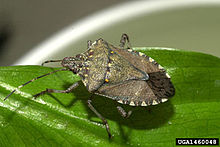I have been asked a few times if the ‘Stink Bugs’ that seem to be dominating Pennsylvania will harm flower beds, gardens, trees, and lawns.
The stink bugs actual name is Brown Marmorated Stink Bug. And well, as you know, they stink.. Especially if they are smashed. These littles insects come from China. The first stink bug was collected from the United States in 1998. Rumor has it that they where brought to the states with shipments from China by Walmart. From what I understand, they originated in the states in Allentown, Pennsylvania.
Will stink bugs harm my bushes and/or trees?
Not that I am aware of. I have never read that they destroy trees. It might become noticed in the future, but currently I have not heard of such a case. So far the answer is no.
Will stink bugs destroy my lawn in any way?
Again, not that I am aware of. Again, so far the answer is no.
Do stink bugs harm crops?
Yes, they do. They cause damage to fruit and vegetable crops and are a extremely high agricultural pest. The bug begins to feed in May / June. They feed from apples, cherries, green beens, soy beans, respberries, and pears, and peaches. I am sure the list contains, but these are the highest damaged fruit crops that the bug feeds from.
Stink bugs have invaded my home!
These bugs are not dumb. They will squeeze themselves into any where they can possibly fit in order to find shelter, to of course, survive the winter months. And your home is no exception. They normally hibernate, however, due to our indoor heating, they become after and fly clumsily around banging into things. Very annoying.
The climate in the United States has allowed them to produce twice as fast as in Asia.
Best way to get rid of a stink bug?
Flush it in the toilet, or, spray them with dish soap mixed with water. It eats the exoskeleton and kills them. Squashing these bugs with a fly swatter or other means causes them to emit there horrible odor. Try not to ‘upset’ the bug as well, this causes them to release there odor. Think of them as a really, really, really small skunk..
Have you started to notice damage from what you thought was caused by a stink bug, but have learned it wasn’t? Still not sure? Leave a comment on this post with the symptoms. Provide as much detail as possible and we will try to give you an answer as to what may have caused the damage. We may even be available (depending on your area) to come and give you a free diagnostics of the damage, and work with you to correct it.
